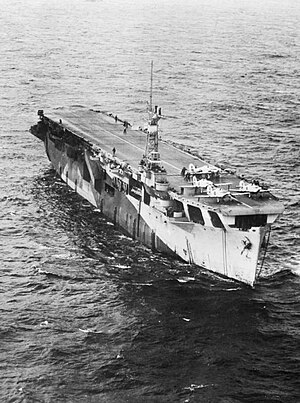Nairana-class escort carrier

HMS Nairana
|
|
| Class overview | |
|---|---|
| Name: | Nairana class escort carrier |
| Builders: | |
| Operators: | Royal Navy |
| Preceded by: | HMS Activity |
| Succeeded by: | Long Island-class escort carrier |
| Built: | 1941–1944 |
| In service: | 1943–1955 |
| Planned: | 3 |
| Completed: | 3 |
| General characteristics | |
| Type: | Escort carrier |
| Displacement: | |
| Length: |
|
| Beam: |
|
| Draught: |
|
| Installed power: | 11,000 bhp (8,200 kW) |
| Propulsion: | 2 shaft diesel engines |
| Speed: | 17 knots (31 km/h; 20 mph) |
| Complement: |
|
| Armament: |
|
| Aircraft carried: | 15–20 |
The Nairana-class escort carrier (/naɪˈrɑːnə/) was a British-built class of three escort carriers. They were constructed one each in England, Scotland and Northern Ireland to the same basic design during the Second World War for service with the Royal Navy.
Converted from merchant ships, they were only able to accommodate a composite squadron of about 15–20 aircraft. Their armaments were mainly anti-aircraft weapons, with one twin 4 inch Dual Purpose, Anti Aircraft gun. One of the class, Campania, was the first British carrier to be fitted with an Action Information Organisation (AIO) and a Type 277 Radar able to detect low-level aircraft.
Once completed the first carrier did not take part in active service until January 1944, but all three served as convoy escorts during the final year of the war. They had some success during their patrols, and anti-submarine Fairey Swordfish flying from their decks sank and damaged some German U-boats and their fighters succeeded in shooting down German long-range reconnaissance aircraft.
The Nairana-class escort carriers were a class of three escort carriers built for the Royal Navy during the Second World War. Escort carriers were designed to protect convoys of merchant ships from U-boat and aircraft attack. Following the successful conversion and operation of HMS Activity, the Admiralty decided to take over three more merchant ships while they were still under construction and convert them into escort carriers. The three ships chosen were being built at three different shipyards around the United Kingdom, Harland and Wolff in Northern Ireland, Swan Hunter in England and John Brown & Company in Scotland. The prototype was built by John Brown who supplied the other two companies with copies of the plans. The three ships were supposed to be identical but in reality they were all slightly different.
...
Wikipedia
